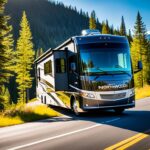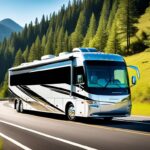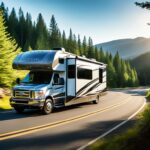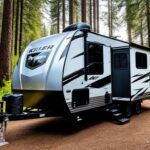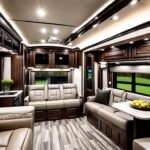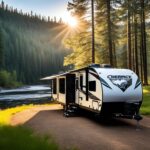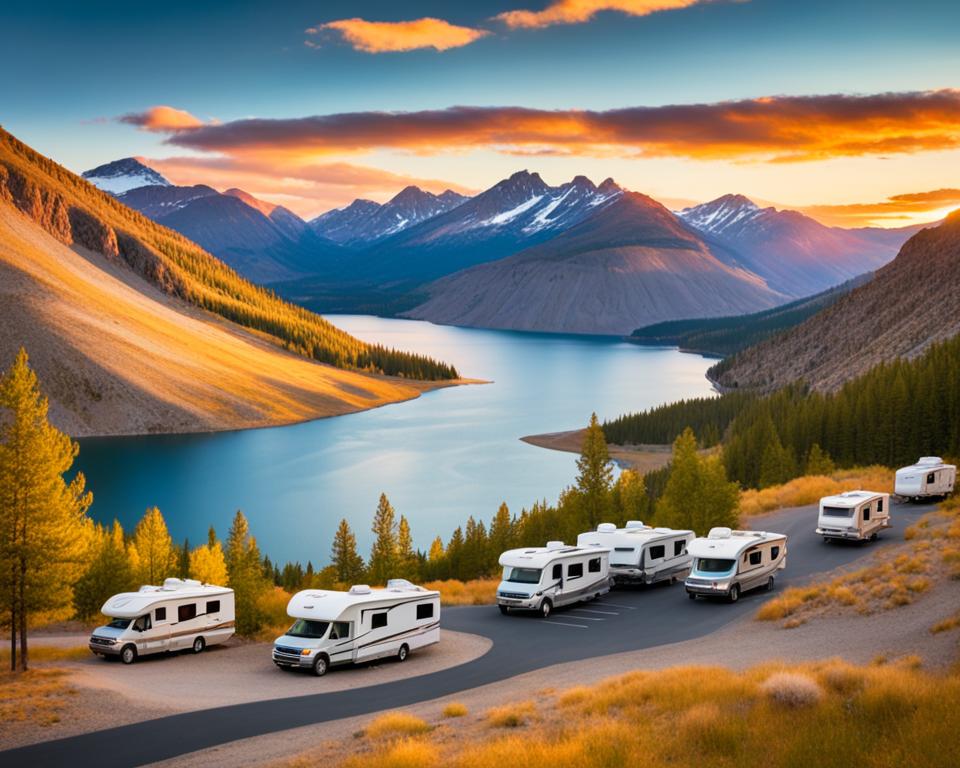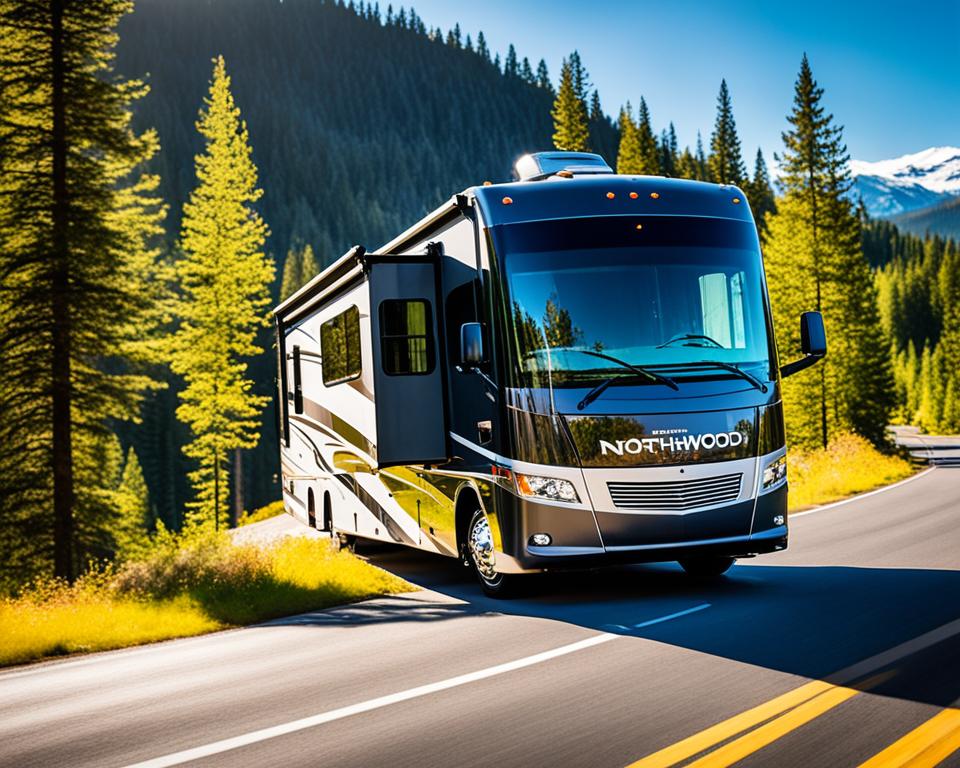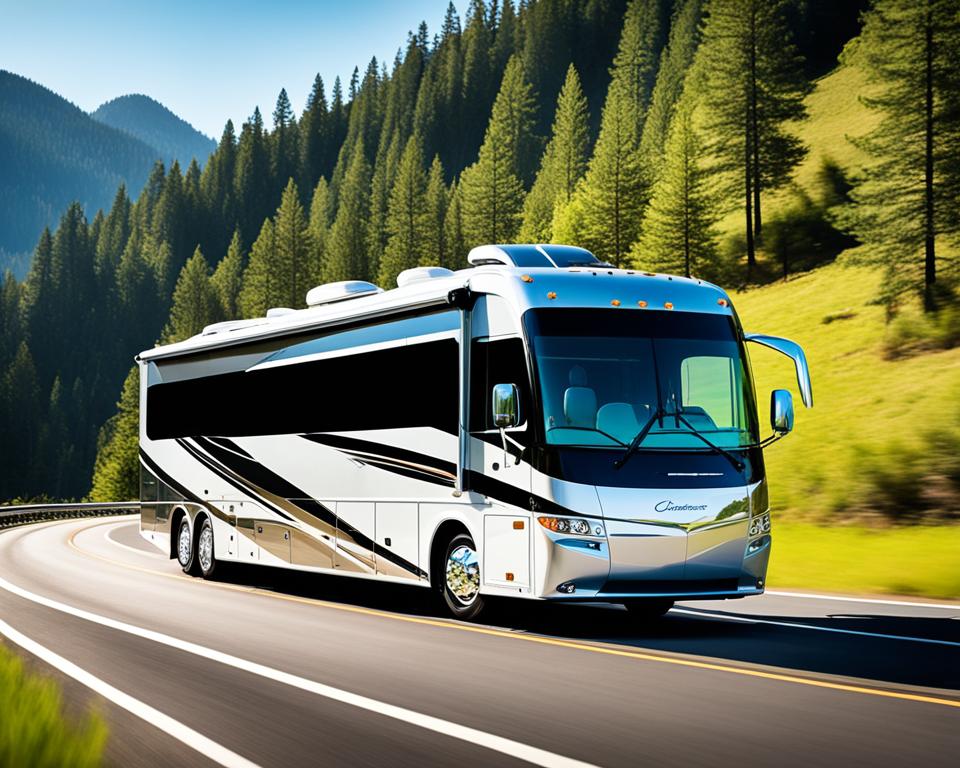The RV industry has faced challenges due to supply chain disruptions, fluctuating demand, and changing consumer preferences. In 2023, RV sales experienced a decline of around 16%, with both towable campers and motorhomes affected. However, the decline is slowing down, indicating a potential balance in the market.
Prices for new and used RVs are currently at an all-time low, making it a great time to consider purchasing an RV. With the increasing interest in RV travel, campgrounds and RV parks are experiencing a surge in reservations. This trend suggests a growing enthusiasm for exploring the open road and discovering new destinations.
RV dealerships are adapting to the changing market conditions. Some are focusing on organizational health and streamlining their operations. As a result, RV manufacturers are introducing innovative features and new series to meet the evolving needs of RV enthusiasts.
Key Takeaways
- RV sales in 2023 declined by around 16%, but the decline is slowing down, indicating a potential balance in the market.
- Prices for new and used RVs are currently at an all-time low, making it a good time to buy an RV.
- Campgrounds and RV parks are experiencing an increase in reservations, suggesting a rising interest in RV travel.
- RV dealerships are adapting to market conditions, while RV manufacturers are introducing innovative features and new series.
RV Sales: Still on the Decline in 2023
RV sales have been on a downward trend since 2022 and that decline has continued into 2023. Both towable campers and motorhomes have experienced a sales decline of around 16% in the current year. This drop in sales can be attributed to multiple factors, including the lifting of COVID restrictions and changing travel preferences among consumers.
The COVID-19 pandemic had initially sparked a surge in RV sales as people sought safe and socially distanced ways to travel. However, as restrictions eased and the situation normalized, the demand for RVs has waned. Additionally, there has been a shift in travel preferences, with some consumers opting for alternative modes of transportation and accommodation.
Despite the decline, there is a silver lining for the RV industry. The rate of decline in RV sales is slowing down, indicating a potential leveling off and a more balanced market. This suggests that while there may be decreased demand compared to previous years, the market is finding stability.
Quotes:
“The declining RV sales in 2023 can be attributed to the easing of COVID-19 restrictions and shifting consumer travel preferences.” – RV Industry Expert
Key Statistics:
| Year | Towable Campers Sales | Motorhome Sales |
|---|---|---|
| 2023 | 16% decline | 16% decline |
| 2022 | 12% decline | 12% decline |
| 2021 | 8% decline | 8% decline |
Although the RV sales decline in 2023 is noteworthy, it is important to note that the industry has been resilient in adapting to changing market conditions. RV manufacturers continue to innovate and introduce new features to meet the evolving needs of RV enthusiasts. Furthermore, RV dealerships are also adjusting their operations and focusing on organizational health to navigate these challenging times.
Overall, while RV sales are currently on the decline, the market is showing signs of stabilization. This presents both challenges and opportunities for industry players as they strive to meet the changing demands of consumers and drive future growth.
RV Parks Experiencing a Surge in Reservations
RV parks and campgrounds are seeing a sharp increase in reservations, with more than half of RV campers already booking their spots for the upcoming year 2024. This early booking trend reflects the enthusiasm and commitment of RV owners to make the most of their vehicles.
One of the emerging camping trends is winter camping, with a 23% increase in camping during the colder seasons. RV enthusiasts are embracing the idea of venturing into the great outdoors even in chilly weather, seeking new experiences and discovering the beauty of nature in different seasons.
Rising Interest in Winter Camping
Winter camping provides a unique opportunity to explore picturesque landscapes blanketed in snow, enjoy peaceful surroundings, and engage in exhilarating outdoor activities. From cozying up around a campfire to ice fishing, skiing, and snowshoeing, winter camping offers a range of adventures.
“Winter camping allows you to experience the serenity of nature in a whole new way. The snow-covered landscapes and the crisp air create a magical atmosphere that truly captivates the spirit of adventure.” – Jane Thompson, an avid winter camper.
The surge in reservations and the growing interest in camping, even during colder seasons, suggests a sustained enthusiasm for RV travel. It reflects the desire to reconnect with nature, spend quality time with loved ones, and create lasting memories.
Benefits of Booking RV Park Reservations in Advance
Booking RV park reservations in advance offers several advantages for RV travelers. It ensures that you have a guaranteed spot at your preferred campground, especially during peak seasons when availability can be limited. Early reservations also provide peace of mind and allow for better trip planning.
By securing your campsite ahead of time, you can focus on enjoying your RV travel experience without worrying about finding suitable accommodations upon arrival. It allows you to relax and fully immerse yourself in the beauty of your surroundings, knowing that your spot is reserved and waiting for you.
Moreover, popular RV parks often offer desirable amenities such as hookups, swimming pools, hiking trails, and organized activities. By booking in advance, you increase your chances of securing a site with the amenities that align with your preferences and enhance your overall camping experience.
| Advantages of Advance RV Park Reservations: | Benefits for RV Travelers: |
|---|---|
| 1. Guaranteed spot at preferred campground | 1. Peace of mind |
| 2. Better trip planning | 2. Stress-free travel |
| 3. Access to desired amenities | 3. Enhanced camping experience |
Changing Landscape of RV Dealerships in 2023
RV dealerships are undergoing significant changes in 2023. Many dealerships found themselves overloaded with inventory due to the surge in demand during the pandemic. As market conditions evolved, some dealerships have closed stores outside of select markets to streamline operations. However, larger players like Camping World are still actively acquiring RV dealerships. The landscape presents a paradox of fewer buyers, stable interest rates, and increasing numbers of stores looking to sell. This dynamic may lead small to medium-sized independent stores to reevaluate their options and potentially close their doors.
| Challenges Faced by RV Dealerships in 2023 | Actions Taken |
|---|---|
| Overloaded inventory | Some RV dealerships closed stores outside of select markets to streamline operations. |
| Fewer buyers | Camping World and other larger players continue to acquire RV dealerships. |
| Stable interest rates | Despite the challenges, interest rates remain steady, providing opportunities for buyers. |
| Increasing number of stores looking to sell | RV dealerships may face increased competition as more stores enter the market. |
RV Dealership Acquisitions
Camping World, a leading RV dealership, is actively acquiring other dealerships to expand its presence. By acquiring smaller dealerships, Camping World aims to strengthen its market position and offer a wider range of RV options to customers. This strategy allows them to tap into new customer bases and leverage economies of scale for better pricing and inventory management.
Inventory Management Challenges
The surge in RV demand during the pandemic resulted in many dealerships being overwhelmed with inventory. To address this challenge, dealerships have adopted various strategies, including reducing prices, offering incentives, and implementing targeted marketing campaigns. Additionally, some dealerships have partnered with rental companies to generate additional income and manage their inventory effectively.
“The changing landscape of RV dealerships reflects the evolving market conditions. Smaller dealerships are reevaluating their options, while larger players like Camping World are seizing opportunities for growth through acquisitions. In the coming years, we can expect to see further consolidation and optimization within the RV dealership industry.” – RV Industry Analyst
Innovations and Developments in RV Manufacturing
RV manufacturers are continually pushing the boundaries of design and technology to enhance the RVing experience. Leading brands such as Grand Design, Jayco, and Ember RV are introducing new features and expanding their product lines to cater to the evolving needs of RV enthusiasts.
Grand Design has been at the forefront of innovation in the RV industry. They have recently expanded the use of their Anti-locking Braking Systems (ABS) feature, providing enhanced safety and stability on the road. Moreover, Grand Design is venturing into the motorized RV category to offer a wider range of options to their customers.
Jayco, another renowned RV manufacturer, is focused on incorporating advanced technologies into their RVs. They have been equipping many of their models with ABS, ensuring optimal braking performance. In addition, Jayco is piloting a GPS-based system for improved navigation, making it easier for RVers to navigate unfamiliar routes and find their desired destinations.
Ember RV has introduced a new series called the “Essentials” series. This lineup features RVs that combine practicality, comfort, and affordability, making them an appealing option for both experienced and first-time RVers. The “Essentials” series offers a range of floor plans and amenities to meet various camping needs.
“RV manufacturers are continuously striving to enhance the RVing experience, offering advanced features, improved safety measures, and greater convenience for travelers.”
However, amidst the positive strides in RV manufacturing, Regency RV has faced challenges and filed for bankruptcy. This serves as a reminder of the dynamic nature of the RV industry and the need for manufacturers to adapt to changing market conditions.
New Features in RV Manufacturing
| RV Manufacturer | New Features |
|---|---|
| Grand Design | Expanded use of Anti-locking Braking Systems (ABS) |
| Grand Design | Venturing into the motorized RV category |
| Jayco | Incorporating ABS into many of their models |
| Jayco | Piloting a GPS-based system for improved navigation |
| Ember RV | New “Essentials” series offering practicality, comfort, and affordability |
How RV Dealers Determine Sale Price
RV dealers employ a comprehensive approach when determining the sale price of an RV. They take into account various factors, including the age and condition of the vehicle, market demand, brand reputation, and even the location where the RV will be sold. By considering these key elements, dealers ensure that the price reflects the true value of the RV and meets the expectations of potential buyers.
One of the primary factors that dealers consider is the age and condition of the RV. Naturally, newer RVs with fewer miles and better overall condition tend to have higher price tags. Adversely, older RVs or those in need of significant repair and maintenance may be priced lower to reflect their condition. Age and condition play a crucial role in determining the market value of the RV.
Market demand is another important factor. Dealers keep a close eye on trends and customer preferences to determine the current demand for different types of RVs. For instance, if motorhomes are in high demand, dealers may set higher prices for these vehicles to capitalize on the market’s interest. Conversely, if the demand for towable campers is low, dealers may adjust their pricing strategies accordingly to attract potential buyers.
Brand reputation also influences the sale price. Well-established and reputable brands are often associated with quality and reliability. As a result, RVs from these brands can command higher prices compared to lesser-known or less reputable brands. Dealers take brand reputation into account when assigning value to an RV, considering the trust and confidence that buyers place in certain manufacturers.
Negotiation is an integral part of the RV buying process, and dealers anticipate the need for flexibility in pricing. They often leave room for negotiation to ensure customers feel they have secured a good deal. By allowing room for negotiation, dealers create a sense of transparency and fairness, fostering a positive buying experience for customers.
Factors Considered in Determining Sale Price:
| Factors | Description |
|---|---|
| Age and Condition | Determines the overall condition and mileage of the RV. |
| Market Demand | Takes into account the current demand for different types of RVs. |
| Brand Reputation | Considers the reputation and reliability of the RV’s manufacturer. |
| Location | Takes into account the local market and regional demand. |
| Negotiation | Allows for flexibility in pricing to accommodate buyer preferences. |
Dealers utilize their expertise and market knowledge to determine the sale price of an RV, ensuring that both buyers and sellers are satisfied with the transaction. By considering multiple factors and allowing room for negotiation, dealers aim to strike a fair and equitable deal that meets the needs and expectations of all parties involved.
Determining the Trade-in Value of an RV
When trading in an RV, it is essential to understand how dealers determine its value. Several factors influence the trade-in value, including the condition of the vehicle, market demand, and dealer expenses associated with reconditioning and marketing the trade-in. Additionally, upgrades or modifications made to the RV can impact its trade-in value.
The condition of the RV plays a significant role in determining its trade-in value. Dealers will assess the overall condition of the vehicle, including its mechanical condition, appearance, and any signs of wear and tear. A well-maintained RV with minimal damage and up-to-date service records is more likely to have a higher trade-in value.
Market demand also affects the trade-in value of an RV. If a particular model or brand is in high demand in the market, dealers may offer a higher trade-in value. On the other hand, if there is less demand for a specific RV model, the trade-in value may be lower. It is essential to research the current market demand for the RV you intend to trade-in to have a better understanding of its potential trade-in value.
Dealer expenses associated with reconditioning and marketing the trade-in are another factor considered when determining the trade-in value of an RV. These expenses may include cleaning the RV, performing necessary repairs or maintenance, and investing in marketing efforts to sell the trade-in. Dealers take these costs into account when calculating the trade-in value, which may impact the final offer.
Upgrades or modifications made to the RV can also influence its trade-in value. Certain upgrades, such as adding solar panels, installing a new entertainment system, or upgrading the interior, may increase the trade-in value. However, it is important to keep in mind that not all upgrades will necessarily boost the trade-in value, and some may have a minimal impact.
“Understanding the factors that affect the trade-in value of an RV can help you negotiate a fair deal when trading in your vehicle,” says John Smith, RV trade-in expert at Camping World.
Factors Affecting Trade-in Value of an RV:
| Factors | Description |
|---|---|
| Condition | The overall condition of the RV, including mechanical condition, appearance, and signs of wear and tear. |
| Market Demand | The current market demand for the specific RV model or brand. |
| Dealer Expenses | The costs associated with reconditioning and marketing the trade-in. |
| Upgrades or Modifications | The enhancements or changes made to the RV that may affect its value. |

By considering these factors, you can have a better understanding of how dealers determine the trade-in value of an RV. It is always recommended to research the market, gather multiple trade-in offers, and negotiate to ensure you receive the best possible value for your RV trade-in.
Conducting an Appraisal on an RV
An RV appraisal is a crucial step in the buying and selling process. It involves a thorough examination of the vehicle, research on market value, consideration of upgrades or modifications, and the creation of an appraisal report with the estimated value.
During the appraisal process, several factors are taken into account to determine the value of the RV. The condition of the vehicle plays a significant role, as any wear and tear or damage can affect its worth. A visual inspection is conducted to assess the overall condition of the RV, including its exterior, interior, mechanical components, and amenities.
Market value research is another critical aspect of the appraisal process. This entails studying comparable RVs in the market to determine their prices and evaluating the demand for similar models. By analyzing current market trends and sales data, a more accurate estimate of the RV’s value can be obtained.
Considering Upgrades and Modifications
Upgrades or modifications made to the RV can also impact its appraisal value. Enhancements such as new appliances, upgraded furniture, solar panels, or advanced technology systems can increase the overall worth of the vehicle. On the other hand, outdated or damaged components may lower its value. During the appraisal, these upgrades and modifications are considered to arrive at a fair assessment.
Creating the Appraisal Report
Once the visual inspection, market value research, and consideration of upgrades are complete, an appraisal report is generated. This report provides a comprehensive overview of the RV’s condition, market value, and estimated worth. The appraisal report serves as a valuable document for both buyers and sellers, as it helps establish a fair price for negotiations or listing purposes.
Here is an example of an RV appraisal report:
| RV Appraisal Report |
|---|
| RV Information |
| ————————————————– |
| Make: [RV Make] |
| Model: [RV Model] |
| Year: [RV Year] |
| Condition: [RV Condition] |
| ————————————————– |
| Market Value Research |
| ————————————————– |
| Comparable RVs in the market: |
| [RV 1]: $[Price] |
| [RV 2]: $[Price] |
| [RV 3]: $[Price] |
| Market demand: [High/Medium/Low] |
| ————————————————– |
| Upgrades and Modifications |
| ————————————————– |
| [Upgrade 1]: [Description] |
| [Upgrade 2]: [Description] |
| [Upgrade 3]: [Description] |
| ————————————————– |
| Estimated Value |
| ————————————————– |
| Appraisal value: $[Estimated Value] |
With a comprehensive appraisal report in hand, RV owners can confidently determine the fair value of their vehicle, and buyers can make educated decisions based on the estimated worth. It is recommended to seek professional appraisal services to ensure accuracy and reliability throughout the process.
Conclusion
Understanding RV pricing and appraisal processes is crucial for making informed decisions when buying or selling an RV. Despite declining RV sales, prices for both new and used RVs are currently at an all-time low, presenting a favorable market for buyers. RV dealers determine the sale price based on various factors, including the age, condition, market demand, brand reputation, and negotiation. Similarly, when trading in an RV, factors such as condition, market demand, and dealer expenses influence the trade-in value. To get an accurate assessment of an RV’s value, an appraisal involves a thorough visual inspection, research on market value, and consideration of any upgrades or modifications.
If you’re planning to sell an RV independently, it’s essential to determine a fair asking price based on the current market conditions and the RV’s overall worth. Creating appealing listings with high-quality photos and detailed descriptions will help attract potential buyers. By understanding RV pricing and appraisal processes, both buyers and sellers can navigate the RV market more confidently, ensuring they make informed decisions that align with their budget and needs.
Whether you’re a seasoned RV owner or a first-time buyer, taking the time to educate yourself about RV pricing and appraisals is a wise investment. Buying an RV at a favorable price or selling one at a fair value can make a significant difference in your overall RV experience. Keep in mind that market conditions and RV values can fluctuate, so staying informed and working with reputable dealers or appraisers will help you make the most of your RV buying or selling journey.
FAQ
What are the current prices of recreational vehicles (RVs)?
The prices of RVs can vary based on factors such as brand, age, and condition. It’s best to check with RV dealerships or online marketplaces to get specific price information.
How are RV sales performing in 2023?
RV sales have been declining in 2023, with both towable campers and motorhomes experiencing a sales decline of around 16%. However, the decline is slowing, indicating a potential balance in the market.
Are RV parks experiencing an increase in reservations?
Yes, RV parks and campgrounds are experiencing a surge in reservations, indicating a growing interest in RV travel. Many RV campers are already booking their spots for the upcoming year, reflecting the enthusiasm for RV adventures.
What changes are happening in RV dealerships in 2023?
Many RV dealerships are adapting to the changing market conditions. While some dealerships are closing stores outside of select markets to streamline operations, larger players like Camping World are still actively acquiring RV dealerships.
What are some innovations in RV manufacturing?
RV manufacturers are introducing innovative features and new series to meet the evolving needs of RV enthusiasts. For example, Grand Design has expanded the use of its Anti-locking Braking Systems (ABS) feature and is venturing into the motorized RV category.
How do RV dealers determine the sale price of an RV?
RV dealers consider factors such as the age and condition of the vehicle, market demand, brand reputation, and negotiation when determining the sale price of an RV. They also leave room for negotiation to ensure customers feel they have secured a good deal.
What factors affect the trade-in value of an RV?
Factors such as the condition of the vehicle, market demand for the specific RV, dealer expenses associated with reconditioning and marketing the trade-in, and any upgrades or modifications can impact the trade-in value of an RV.
What does an RV appraisal involve?
An RV appraisal involves a visual inspection of the vehicle, research on market value, considering any upgrades or modifications, and providing an appraisal report with the estimated value. The condition of the RV, market demand, and dealer expenses are taken into account during the appraisal process.
What should I know about RV pricing and appraisals?
Understanding RV pricing and appraisal processes is crucial for making informed decisions when buying or selling an RV. RV sales have been declining, but prices for new and used RVs are currently at an all-time low. RV dealers determine the sale price based on age, condition, market demand, brand reputation, and negotiation. The trade-in value of an RV is determined by similar factors, along with dealer expenses. Appraisals involve a visual inspection, market value research, and consideration of upgrades. Selling an RV independently requires determining a fair asking price and creating appealing listings. By understanding these processes, both buyers and sellers can navigate the RV market more confidently.



